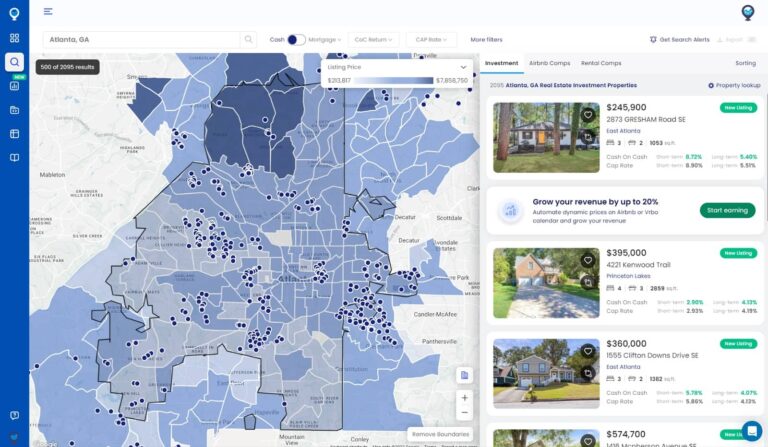Diligent, accurate, and detailed real estate analysis is at the core of making profitable rental property investment decisions.
As a savvy investor, you need to get a solid understanding of the local real estate market, current trends, available properties, and rental rates in order to implement the right strategies and maximize your results.
This article covers everything you need to know about analyzing the potential of both entire markets and individual properties to boost your return on investment. After all, having a successful investment business starts even before buying a property.
Table of Contents
- Understanding the Basics of Real Estate Analysis
- The Role of Market Trends in Property Investment
- Key Metrics for Effective Real Estate Analysis
- Techniques for Accurate Property Valuation
- 6 Steps to Real Estate Analysis
- Leveraging Real Estate Data for Better Investment Decisions
- Tools and Software for Investors
- Using Real Estate Analysis to Empower Your Rental Property Investments
Understanding the Basics of Real Estate Analysis
The comprehensive analysis needed to end up with a positive cash flow property requires both real estate market analysis and investment property analysis. You need to understand the meaning of both these concepts and the steps required to conduct them in order to succeed.
What Is Real Estate Analysis?
In real estate investing, analysis refers to gathering, cleaning, organizing, evaluating, and using reliable data from multiple trustworthy sources on a wide variety of market trends and property metrics. Data has to be collected both at the market level and the property level for optimal results.
The objective of this type of analysis is to learn what factors dictate the current state of the local housing market, what trends prevail in the rental market, what rent prices comparable rentals charge, what occupancy rates landlords enjoy, and – ultimately – what ROI investors can generate.
The Importance of Real Estate Analysis for Investors
Analyzing the market and available real estate listings for sale is fundamental in rental property investing. Knowing historical and current trends allows you to forecast future trends in terms of property prices, rents, occupancies and vacancies, and operating expenses. All these numbers are crucial to calculate your expected rental income, cash flow, and profit.
Moreover, the right type of analysis can help you identify the most lucrative locations, property types, home improvements, and amenities. It will allow you to set the best rental rate to attract tenants without leaving money on the table.
In addition, it is instrumental in dictating your property management approach. Depending on what’s needed in the local market and what cash flow looks like, you can decide whether to hire a professional property manager or be a DIY landlord or Airbnb host, respectively.
In other words, analysis should lead all aspects of your real estate investment strategies if you’re hoping for optimized ROI.
Fundamental Concepts in Real Estate Investment
There are many different concepts and metrics that a real estate investor needs to comprehend and utilize in order to analyze investment opportunities and choose the best one.
Some of the key real estate data points and concepts include:
- Number of available listings for sale
- Days on market
- Median property prices
- Buyer’s market vs seller’s market
- Mortgage rates (as they affect both the homeownership rate – which impacts rental demand – and affordability for investors)
- Rental rate
- Occupancy vs vacancy rates
- Property tax
- Property management fees
- Landlord insurance costs
The combination of all these factors will determine the:
- Rental income
- Cash flow
- Cap rate
- Cash on cash return
The Role of Market Trends in Property Investment

Evaluating market trends plays a crucial role in real estate analysis
The real estate industry is a very dynamic one. The state of the United States housing market is constantly changing, and savvy investors need to be on top of current trends to succeed. A strategy that worked a few short months ago might no longer be valid and bring suboptimal results today.
Identifying and Interpreting Market Trends
Being able to catch and make sense of historical and current trends is at the core of conducting real estate analysis.
Here are the most important real estate metrics to look for when evaluating a market:
- Property prices: First, are housing prices dropping in your market? Trends in home values are a major indicator of current market activities and form the basis of a solid housing market forecast.
- Rental rates: Second, you need to take a look at recent movements in rental prices to get an idea if rental demand is going up or down and whether it’s at equilibrium with rental supply or not.
- Occupancy rates: Third, occupancy shows you whether there is further demand for rental properties in the local market. If occupancy is far from 100%, this might be a signal of oversaturation and no need for more rentals.
Importantly, you have to consider trends in the market for the specific type of property that you are thinking of investing in. The performance of single family homes is usually significantly different from the performance of multi family rentals within the same area.
How Economic Indicators Influence Real Estate Values
Furthermore, in your property market analysis, you need to take into account wider economic and demographic trends.
Some of the most important numbers to include are:
- Economic growth: Strong economic performance will attract migration, which means that more renters will look for housing.
- Tourist activities: Popular tourist destinations with a lot of overnight visitors are ideal for short term rental investing.
- Population growth: It is worth investing in long term rentals in markets with positive demographic trends as there will be a larger pool of tenants.
- Interest rates: Mortgage rates rise together with interest rates, pushing homebuyers out of the market, creating more demand for rentals. Meanwhile, investors usually have access to alternative financing methods and don’t always depend on the prevailing interest rates.
What this means is that starting a successful rental property business is not only about choosing the right market but also choosing the right time. Ideally, through your analysis, you want to find a location with affordable property prices that are on the rise (to benefit from long term real estate appreciation) and increasing rental rates (to generate rental income along the way).
Key Metrics for Effective Real Estate Analysis
A number of numbers are particularly important when analyzing markets and properties.
We will discuss them below.
Understanding ROI in Real Estate
The ultimate goal of performing real estate market analysis is to estimate what return on investment you can expect.
The two most popular ROI metrics for rental properties are:
Cap Rate
Capitalization rate, or cap rate for short, measures the profitability and the risk associated with investing in a particular market and a specific property.
The cap rate is calculated by dividing the net operating income (NOI) by the sales price or the current market value, and the result is multiplied by 100 to get a percentage.
Cash on Cash Return
The cash on cash return is another way to measure profit in real estate.
The cash on cash return is computed as the ratio of the pre-tax annual cash flow over the total cash invested, multiplied by 100. Unlike the cap rate, this metric considers the financing method, which makes it a bit more complicated to calculate but significantly more comprehensive to use.
The Significance of Rental Yield in Investment Properties
Effective analysis in real estate investment includes rental yield.
The gross rental yield is obtained by dividing the annual rental income by the total cost of purchasing the property and turning it into a functional rental.
This makes rental yield similar to the cap rate, with the important difference that the former uses rent, while the latter utilizes NOI.
Other Critical Real Estate Metrics to Consider
In addition to the three data points listed above, real estate analysis needs to include a few more metrics to be truly comprehensive.
These are:
- Rent prices: For short term rentals, this is the Airbnb daily rate, while for long term rentals it is the monthly rent.
- Rental income: This is the total amount of rent that an investor collects per month or per year.
- Net operating income: NOI calculates the total rental income minus all operating expenses (including vacancy), without considering taxes.
- Cash flow: This is the difference between all cash inflows (rental income) and cash outflows (operating expenses, mortgage payments, taxes, etc.).
Techniques for Accurate Property Valuation
Real estate investors apply different methods for estimating the current market value of an asset as part of their analysis, depending on their goals.
Comparative Market Analysis (CMA)
Comparative market analysis in real estate is the most popular type of property valuation. This entails looking at recently sold properties that are similar to the rental that you are analyzing and located within the same area. These are known as real estate comps. The fair market value of the property under investigation is based on the average of the sales prices of similar properties, accounting for any existing differences.
This method is used both when buying and selling properties.
Income Approach to Valuation
Another way to calculate property value is using the income approach. This method bases the price of a house on the rental income that it is able to earn, while also taking into consideration the cap rate.
As the name suggests, this strategy works for income-producing real estate assets such as rental properties.
The Cost Approach and When to Use It
The cost approach refers to a way to assess the value of a property by calculating the total cost of constructing an identical property. This includes the cost of materials, labor cost, and all other expenses needed to build the property.
This approach is best suited for unique homes as it’s not possible to find comps for them.
6 Steps to Real Estate Analysis
Now that you appreciate the importance of reliable analysis, it’s time to get to know how to conduct the necessary research.
At the end of the day, how to do a real estate market analysis boils down to following these steps:
Step 1: Study the Wider US Real Estate Housing Market
The first step in real estate analysis is to check out the general state of the national market. Focus on the larger picture to identify if we are in a buyer’s or seller’s market. Check out interest rates. Find out if people are moving to the major cities or to suburban markets.
Step 2: Focus on City and Neighborhood Trends
Second, you should narrow down your analysis to the local market where you plan to invest. While there are nationwide trends at play, the real estate market is highly localized, which means that cities and areas within them differ majorly from one another.
Step 3: Collect Reliable Real Estate and Rental Data
Third, we cannot overemphasize the importance of gathering a wide range of data from trusted sources. The data and analytics need to comprise all the real estate, rental, and economic metrics that we mentioned above.
Step 4: Analyze Trends in the Data
Next, if you are performing the analysis manually, you need to get all the collected data into a spreadsheet and start your calculations. You should use the historical performance of properties to forecast expected future performance, including property prices, rental rates, occupancy rates, and ROI.
Step 5: Research the Legal Environment for Rental Properties
Another major step is to study rental laws. Both short term and long term rentals are regulated by various legislations, and you should make sure that the market you are considering is conducive to your selected rental strategy.
Step 6: Find Comps
Last but not least, you have to identify both real estate comps and rental comps. This will help you evaluate the fair house market price for your investment property to buy as well as the accurate rental rate to market it at.
Leveraging Real Estate Data for Better Investment Decisions
In your analysis, the real estate data interpretation is only as good as the data itself. That’s why it’s crucial to locate the best sources of data.
Reliable Data Sources for Real Estate Investment
Good real estate analysis requires a lot of different metrics, as we’ve seen above. Thus, an investor needs to tap into many public and non-public resources to obtain all necessary numbers and figures.
Some of the most trusted sources of real estate data in the US market include:
- Public property records
- Bank websites
- Real estate research websites like Zillow and Redfin
- Rental websites like Apartments.com, Rentals.com, HotPads, Airbnb, and Vrbo
As you can imagine, while collecting data from all these websites is needed, it requires a lot of time and effort.
Alternatively, smart real estate investors can use Mashvisor, which acts as a one-stop-shop for all the needs of rental property investors.

Mashvisor provides reliable data for your real estate market and property analysis
Mashvisor provides you with instant access to all the following data points at both the market and property level:
- Property price
- Mortgage data
- Startup costs
- Rental income
- Rental expenses
- Occupancy rate
- Cash flow
- Cap rate
- Cash on cash return
All the data available on the Mashvisor platform comes from reliable national sources and undergoes our strict accuracy check processes.
To get immediate access to the top data for your real estate analysis, sign up for a 7-day free trial of Mashvisor.
Avoiding Common Pitfalls in Data Analysis
Many beginner and experienced investors fall for rookie mistakes when it comes to analyzing real estate opportunities.
Following are some of the most frequent risks you should be aware of in order to protect your ROI in the long term:
- Over-relying on national trends and skipping analysis of local trends
- Not accounting for changing interest rates (with adjustable rate mortgages)
- Using easy-to-obtain data that’s not reliable
- Overestimating rental income
- Underestimating operating costs
- Not getting access to the best tech tools
- Not having a carefully calculated exit strategy (selling an investment property also requires diligent analysis to maximize long term profitability)
While real estate analysis can be done manually, this is far from efficient and effective in 2023 and beyond. Nowadays, there are a myriad of AI-based real estate analysis tools that savvy investors use to make the process not only faster but also more accurate. So, if you don’t benefit from available apps, you are at a serious disadvantage, and your investments will lead to suboptimal results.
Top Real Estate Analysis Software in the Market
Among the dozens of tools for market and property analysis, there is one that stands out: Mashvisor. What makes Mashvisor unique is the fact that it can support investors along the entire real estate investing journey: from choosing a location, through analyzing data and legal regulations, all the way to finding a top-performing property for sale.
Following is a list of the Mashvisor tools that help with the necessary research and analysis to guarantee good ROI:
- Market Finder: You can search for and analyze the best cities for buying a short term or long term rental property.
- Real Estate Heatmap: You can conduct in-depth analysis of neighborhood-level data.
- Property Finder: You can locate the top listings for sale to convert into profitable rentals.
- Investment Property Calculator: You can perform rental property analysis for both rental strategies.
- Airbnb Pricing: You can automate the pricing of your short term rental based on diligent vacation rental market analysis.
- Real Estate Investment Blog: You can learn the ins and outs of real estate market analysis and investment property analysis.
Integrating Technology into Your Investment Strategy
One of the best real estate investment tips you can possibly receive is to benefit from the power of technology in your analysis and decision making. The property market is very competitive, and there is no time to waste on manual data collection from multiple sources and calculations using traditional spreadsheets.
Using Real Estate Analysis to Empower Your Rental Property Investments
Conducting careful real estate analysis is the surefire way to make the right investment decisions. This is how you will know whether this is a good time to buy a property, what markets offer the best return on investment, and which properties will bring the most money.
Regardless of your strategy, the truth of the matter is that there is plenty of profit to be generated in the US rental market. Smart investors take advantage of analytical tools like Mashvisor to find the best opportunities.
To join the myriad of successful investors, sign up for a 7-day free trial of Mashvisor to augment your analysis.

